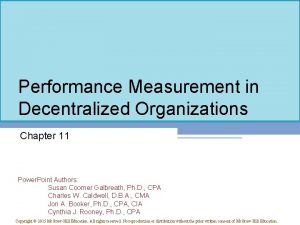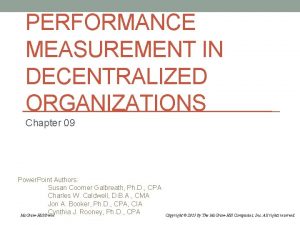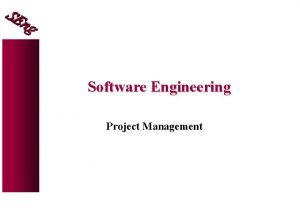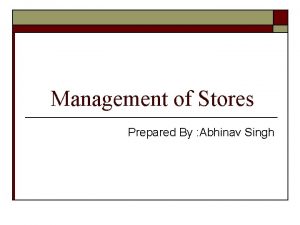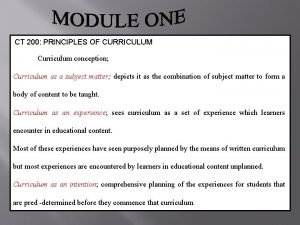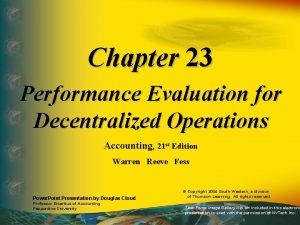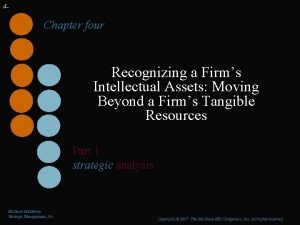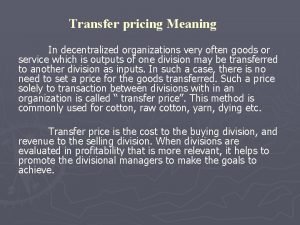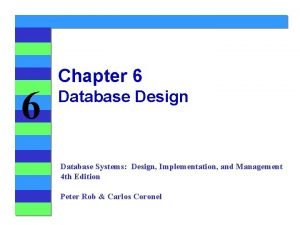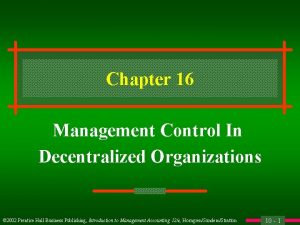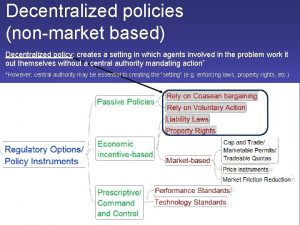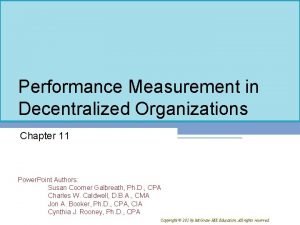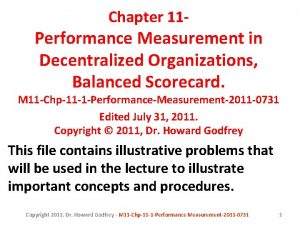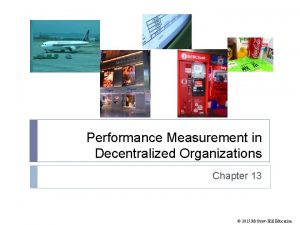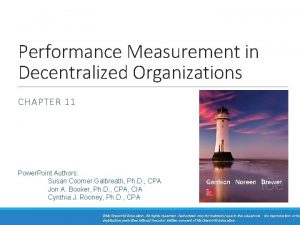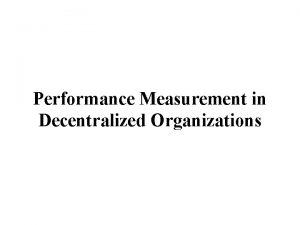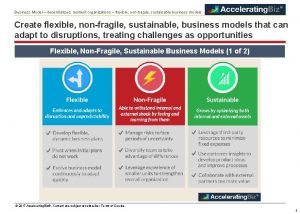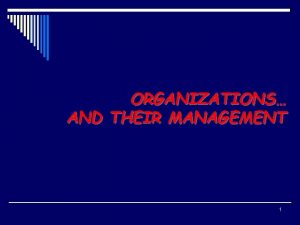Management Control in Decentralized Organizations Chapter 10 2005

















- Slides: 17

Management Control in Decentralized Organizations Chapter 10 © 2005 Prentice Hall Business Publishing, Introduction to Management Accounting 13/e, Horngren/Sundem/Stratton 10 - 1

Profitability as a performance measure Profitability does not mean the same thing to all people. Is it an absolute amount? Is it net income? Income before taxes? A percentage? Net income percentage based on revenue? © 2005 Prentice Hall Business Publishing, Introduction to Management Accounting 13/e, Horngren/Sundem/Stratton 10 - 2

Learning Objective 4 Compute ROI, residual income, and economic value added (EVA) and contrast them as criteria for judging the performance of organization segments. © 2005 Prentice Hall Business Publishing, Introduction to Management Accounting 13/e, Horngren/Sundem/Stratton 10 - 3

Return on Investment投资回报率 ROI = Income ÷ Investment Net income or Operating income Total assets or operating assets © 2005 Prentice Hall Business Publishing, Introduction to Management Accounting 13/e, Horngren/Sundem/Stratton 10 - 4

Return on Investment Division A has an Operating income of $200, 000 and operating asset of $500, 000 Division B has an Operating income of $150, 000 and operating asset of $250, 000 Division A ROI: = Income ÷ Investment $200, 000 ÷ $500, 000 = 40% Division B ROI: = Income ÷ Investment $150, 000 ÷ $250, 000 = 60% © 2005 Prentice Hall Business Publishing, Introduction to Management Accounting 13/e, Horngren/Sundem/Stratton 10 - 5

Return on Investment投资回报率 ROI = Income ÷ Investment ROI = Income Revenue Return on sales 销售利润率 Revenue × Investment Asset/capital turnover 资产周转率 © 2005 Prentice Hall Business Publishing, Introduction to Management Accounting 13/e, Horngren/Sundem/Stratton 10 - 6

Return on Investment投资回报率 For Hewlett-Packard ROI Return on sales ROI = Income Revenue × Revenue Investment © 2005 Prentice Hall Business Publishing, Introduction to Management Accounting 13/e, Horngren/Sundem/Stratton 10 - 7

Return on Investment投资回报率 ROI = Income/ revenue * Revenue/ invested capital 20% = 16/100 * 100/80 Plan 1 25% = 20/100 * 100/80 Plan 2 25% = 16/100 * 100/64 Present Plans JIT can be used to increase asset turnover © 2005 Prentice Hall Business Publishing, Introduction to Management Accounting 13/e, Horngren/Sundem/Stratton 10 - 8

Residual Income(RI, 剩余收益) RI (also called economic profit经济利润) is defined as after-tax net operating income less a capital charge(资本成本). Capital charge is the cost of capital资本成本率 multiplied by the amount of investment(capital invested). Cost of capital is the required rate of return for equity capital and interest rate for debt capital. Also called opportunity cost of capital for capital provider. © 2005 Prentice Hall Business Publishing, Introduction to Management Accounting 13/e, Horngren/Sundem/Stratton 10 - 9

Residual Income剩余收益 Division A has an Operating income of $200, 000, Operating asset of $500, 000 And after-tax cost of capital of 10%. What is the economic profit(residual income)? © 2005 Prentice Hall Business Publishing, Introduction to Management Accounting 13/e, Horngren/Sundem/Stratton 10 - 10

Economic Value Added经济增加值 Economic value added = Adjusted after-tax operating income –after-tax Cost of invested capital (%) × Adjusted average invested capital Adjustments need to make to RI to calculate EVA © 2005 Prentice Hall Business Publishing, Introduction to Management Accounting 13/e, Horngren/Sundem/Stratton 10 - 11

Economic Value Added经济增加值 ROI EVA can be either positive or negative for firms that have positive accounting earnings © 2005 Prentice Hall Business Publishing, Introduction to Management Accounting 13/e, Horngren/Sundem/Stratton 10 - 12

Learning Objective 5 Compare the advantages and disadvantages of ROI or RI to be used as profitability measures of segments. © 2005 Prentice Hall Business Publishing, Introduction to Management Accounting 13/e, Horngren/Sundem/Stratton 10 - 13

ROI or Residual Income? Why do some companies prefer residual income (or EVA) to ROI? Under ROI, the message is go forth and maximize your rate of return, a percentage. Under RI, the message is go forth and maximize residual income, an absolute amount. © 2005 Prentice Hall Business Publishing, Introduction to Management Accounting 13/e, Horngren/Sundem/Stratton 10 - 14

ROI or EVA Segment X with income of $200, 000,invested capital of $1, 000. Segment Y with income of $40, 000,invested capital of $800, 000 Segment X is considering a project that earns 15% annually on a $500, 000 investment, or $75, 000 a year. Segment Y is considering a project that earns 7% annually on a $800, 000 investment, or $56, 000 a year. The capital charge for the project and both segments is 10%. © 2005 Prentice Hall Business Publishing, Introduction to Management Accounting 13/e, Horngren/Sundem/Stratton 10 - 15

ROI or EVA Without Project With Project X Y Income (A) 200, 000 40, 000 275, 000 96, 000 Invested capital (B) 1, 000 800, 000 1, 500, 000 1, 600, 00 ROI ( A÷B ) 20% 5% 18. 3% 6% 125, 000 -64, 000 Cost of capital Economic profit 10% 100, 000 - 40, 000 Economic profit (residual income) =operating Income – cost of capital ×invested capital © 2005 Prentice Hall Business Publishing, Introduction to Management Accounting 13/e, Horngren/Sundem/Stratton 10 - 16

Exercise P 434, 10 -32 P 436, 10 -39 © 2005 Prentice Hall Business Publishing, Introduction to Management Accounting 13/e, Horngren/Sundem/Stratton 10 - 17
 Performance measurement in decentralized organizations
Performance measurement in decentralized organizations Performance measurement in decentralized organizations
Performance measurement in decentralized organizations Chapter 1 introduction to management and organizations
Chapter 1 introduction to management and organizations The non-iid data quagmire of decentralized machine learning
The non-iid data quagmire of decentralized machine learning Staffing and scheduling in nursing management
Staffing and scheduling in nursing management Democratic decentralized in software engineering
Democratic decentralized in software engineering Concept of store management
Concept of store management Planplus decentralized planning system
Planplus decentralized planning system Conception of curriculum
Conception of curriculum Performance evaluation for decentralized operations
Performance evaluation for decentralized operations Decentralized network
Decentralized network Promotional code asdfasdg
Promotional code asdfasdg Decentralized network
Decentralized network Zerocash decentralized anonymous payments from bitcoin
Zerocash decentralized anonymous payments from bitcoin Transfer pricing meaning
Transfer pricing meaning Astratum
Astratum Decentralized volume this year
Decentralized volume this year Database design life cycle
Database design life cycle
